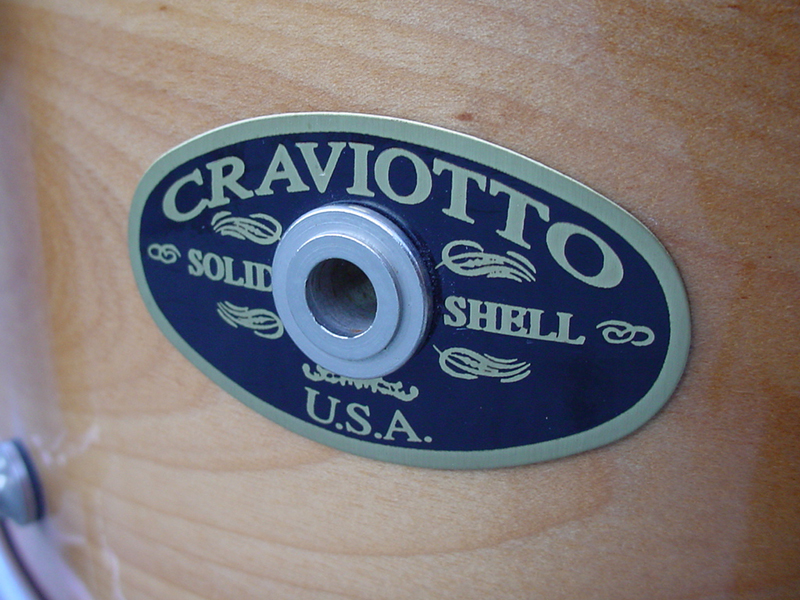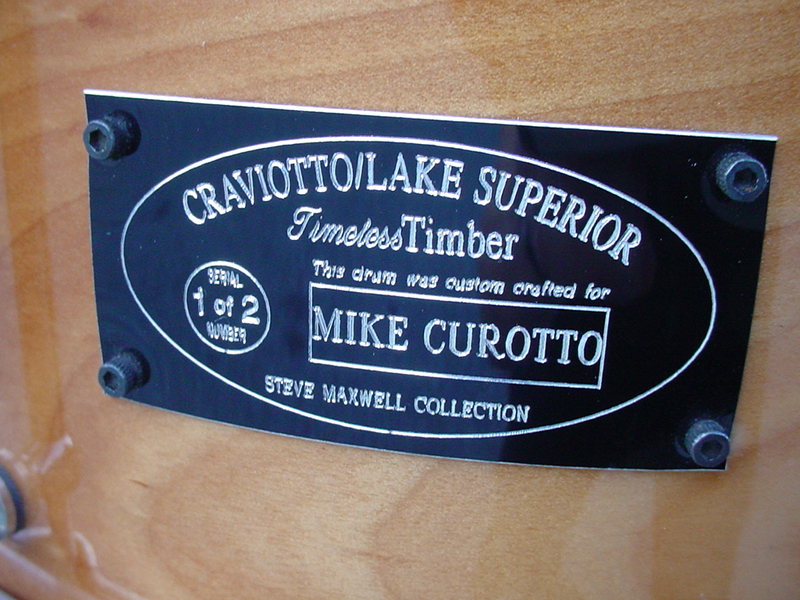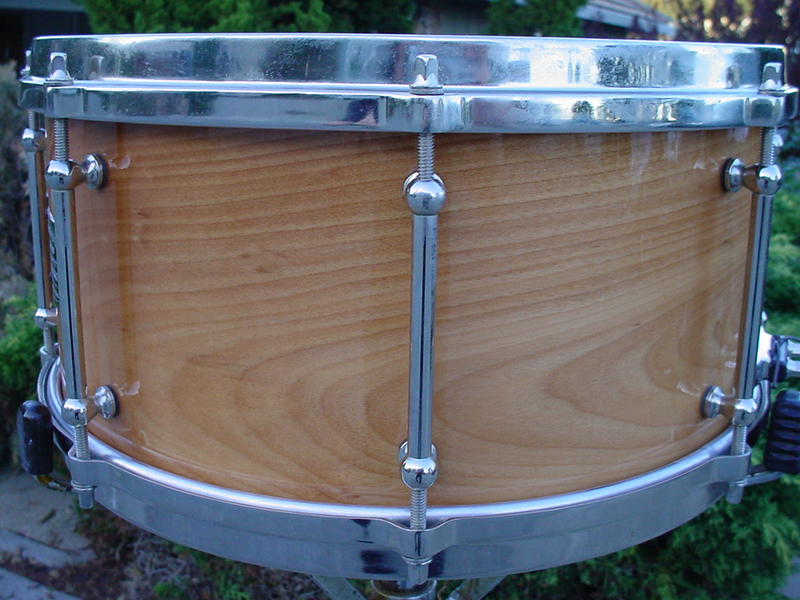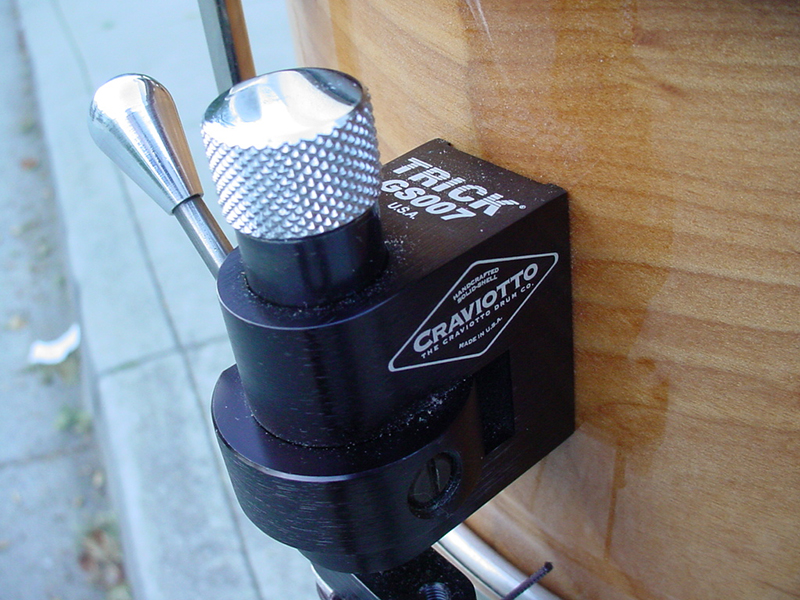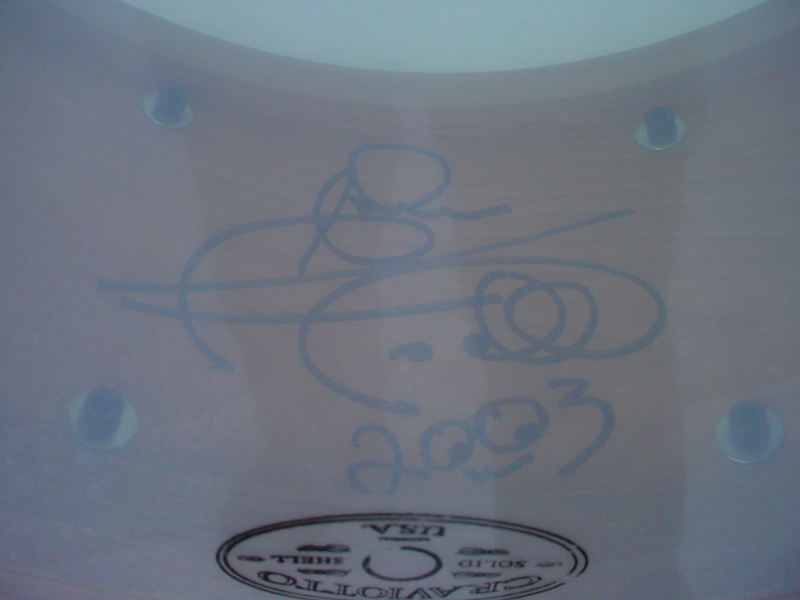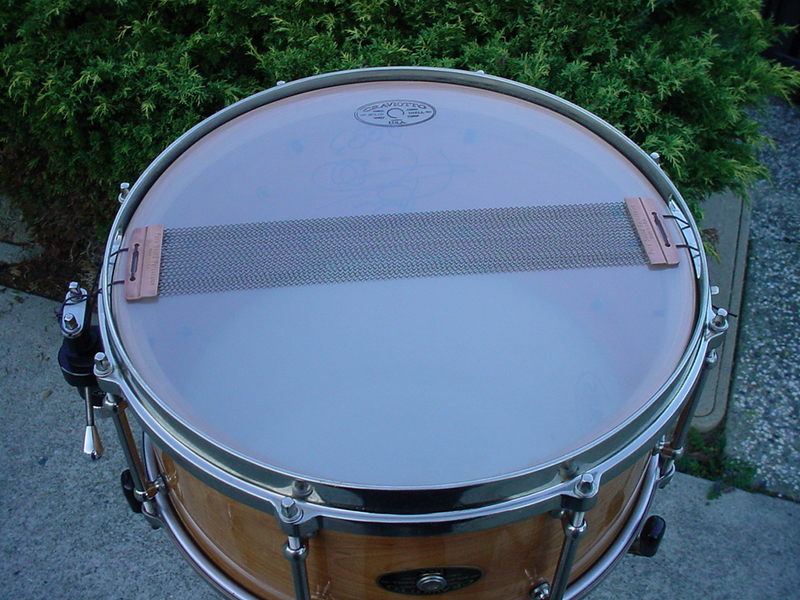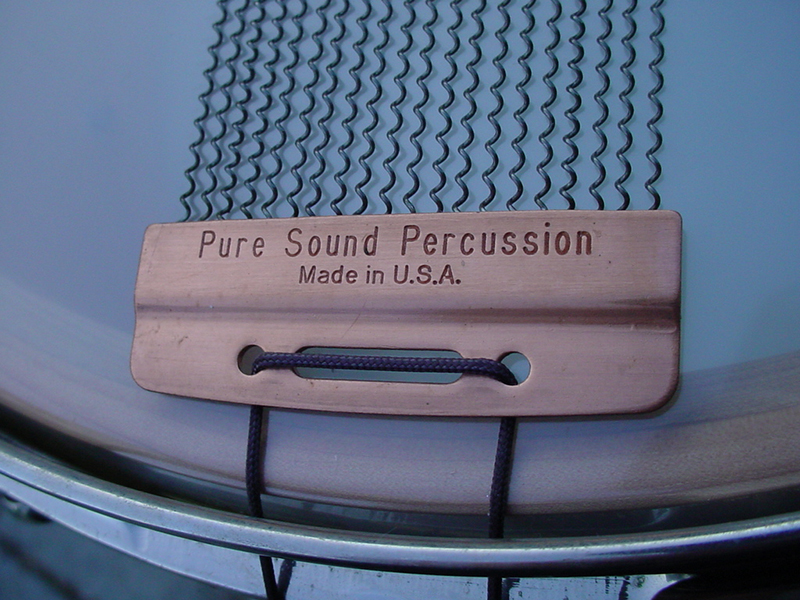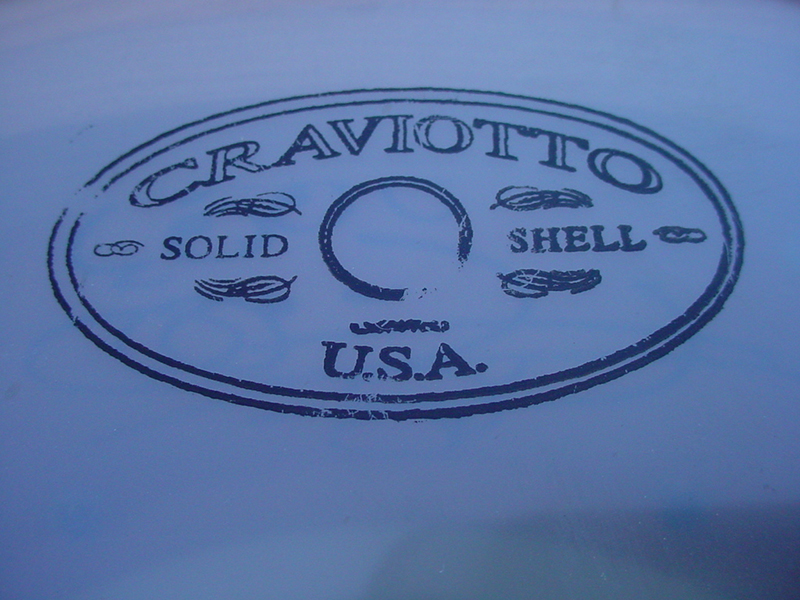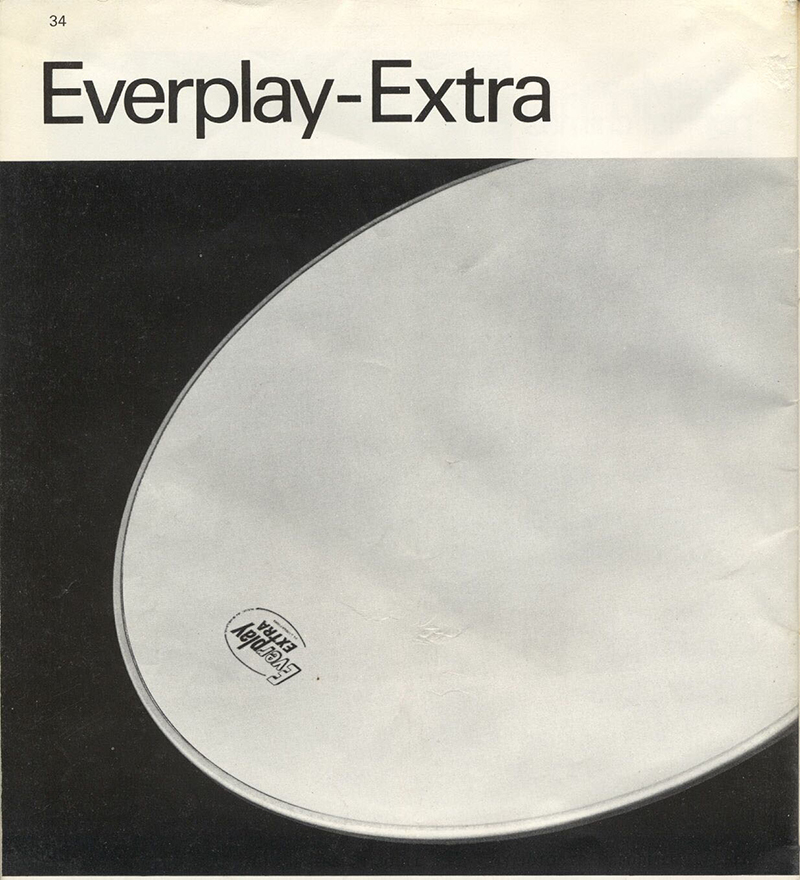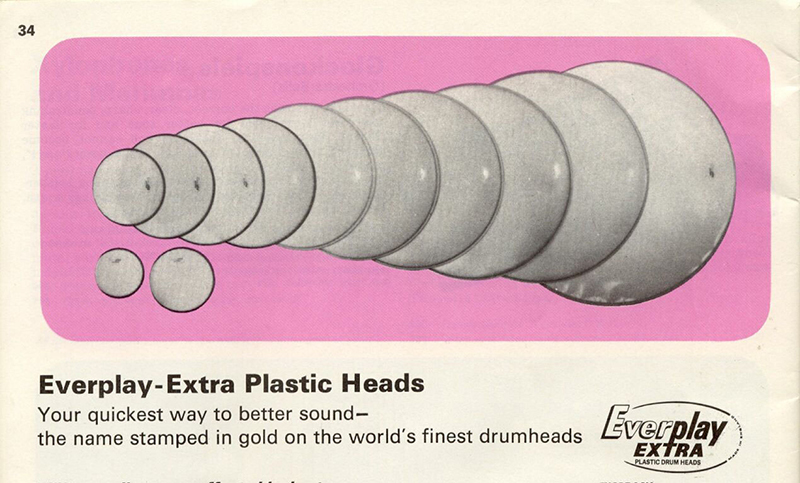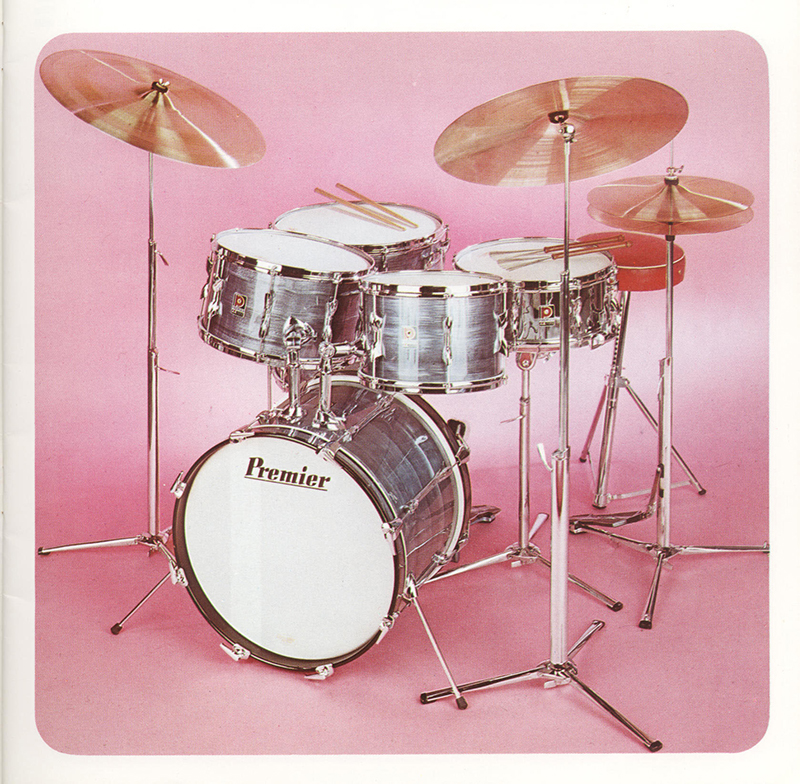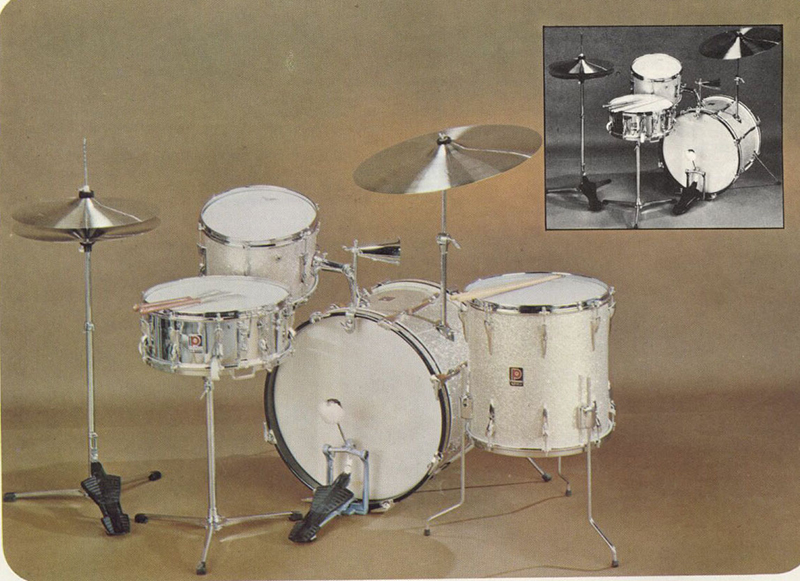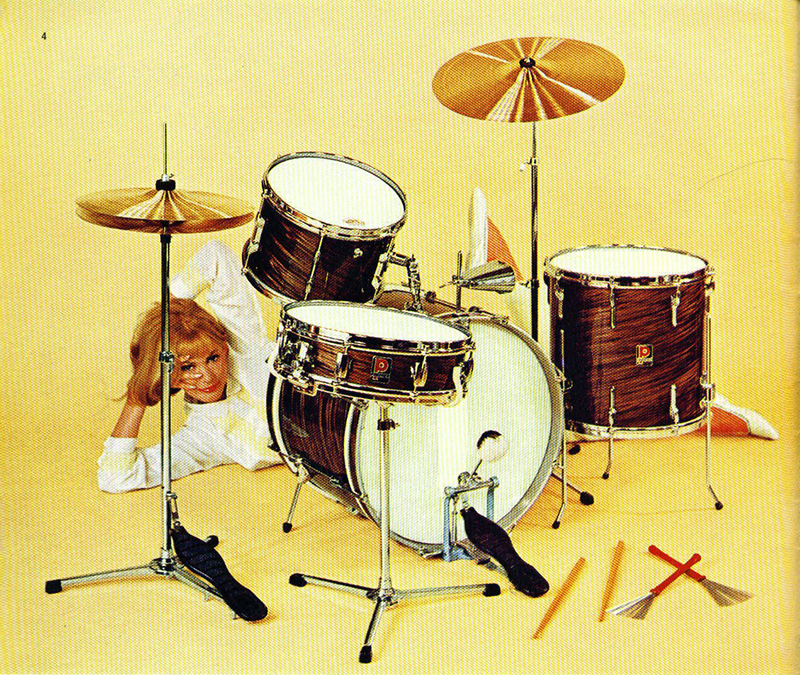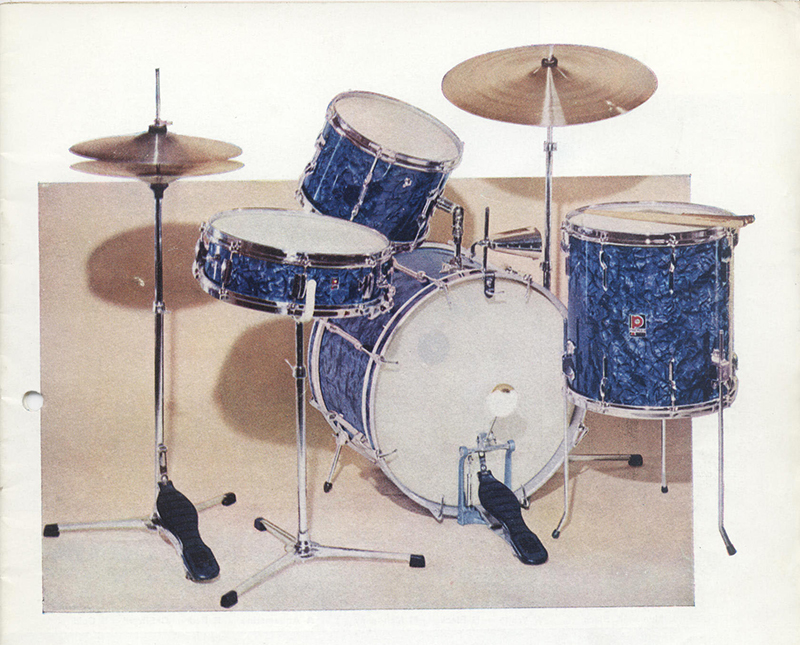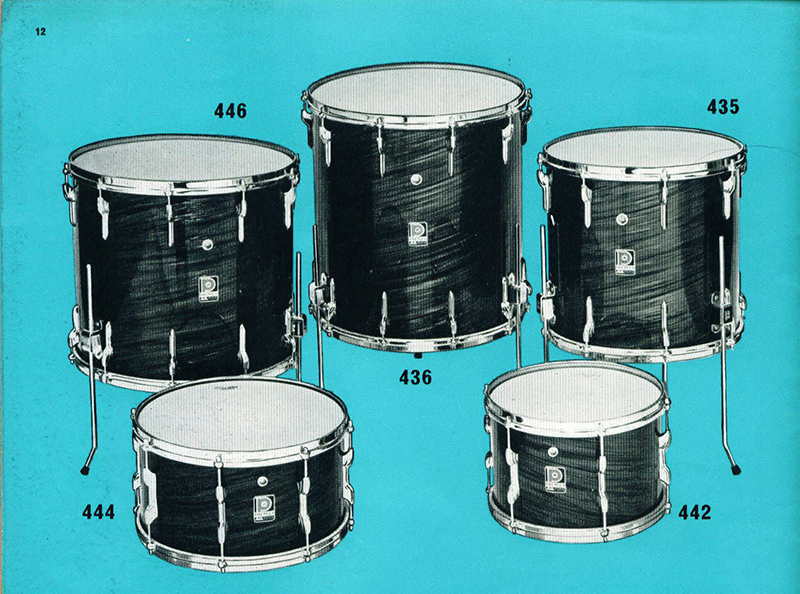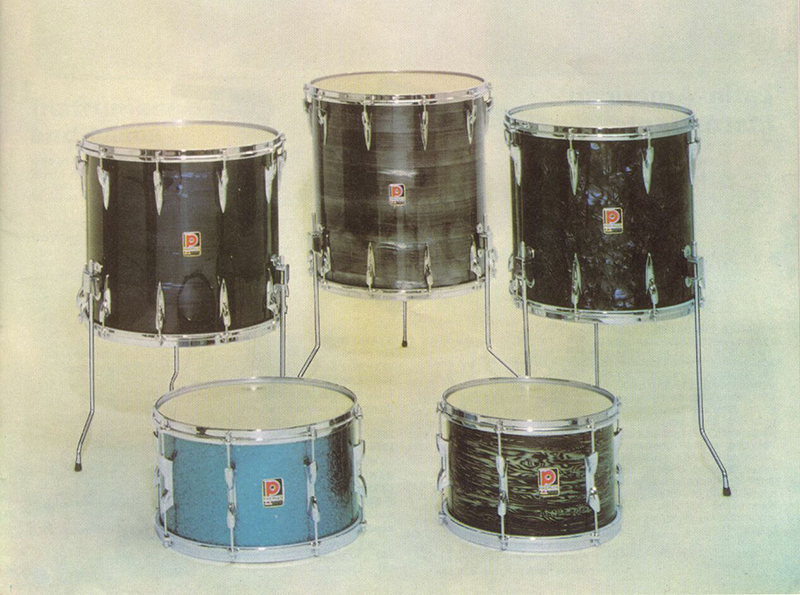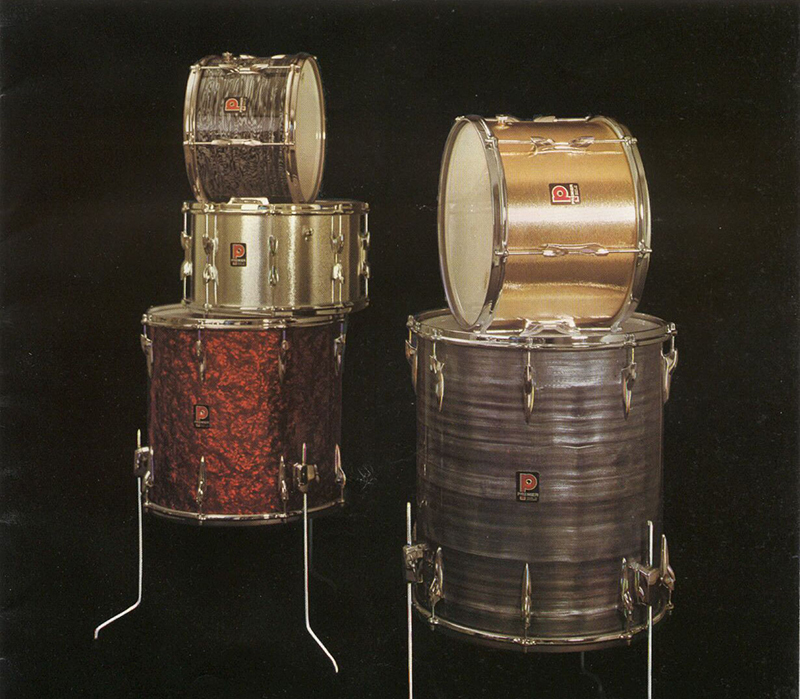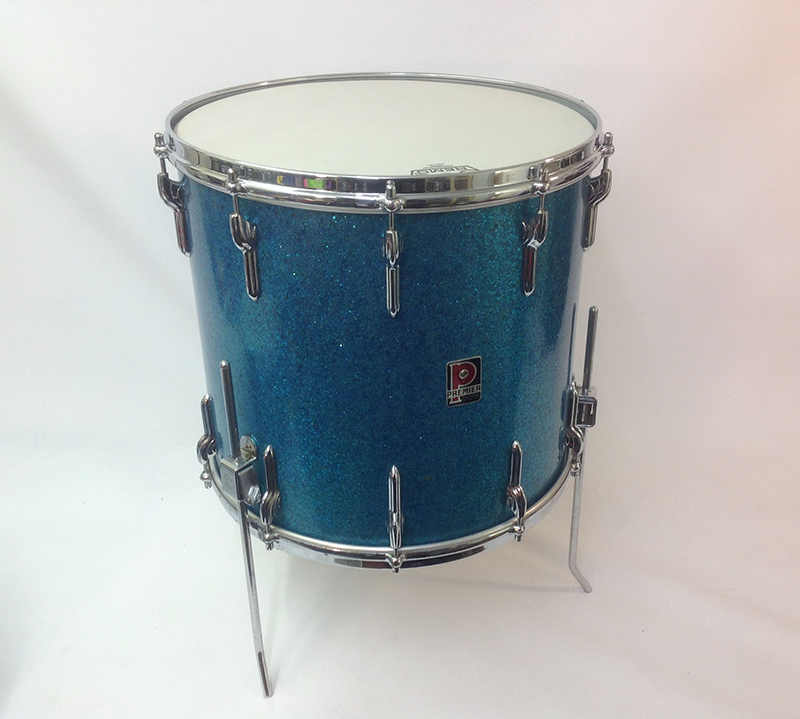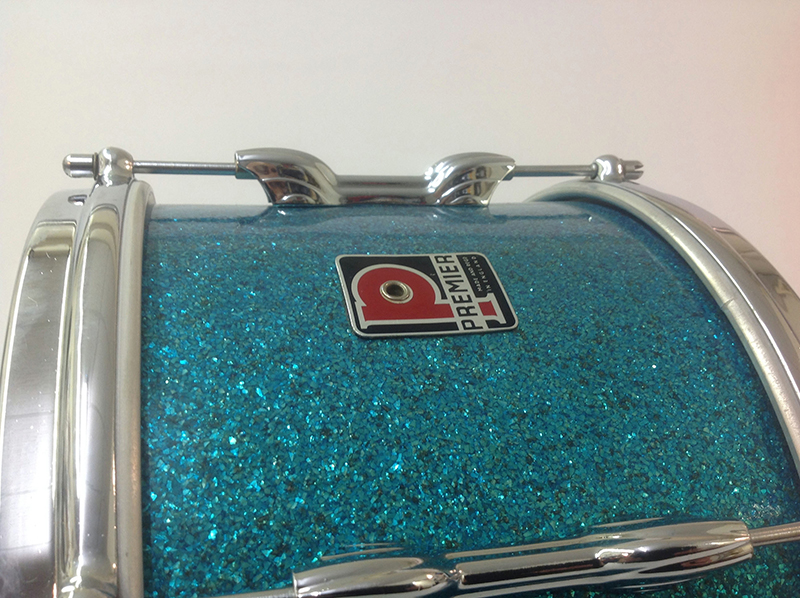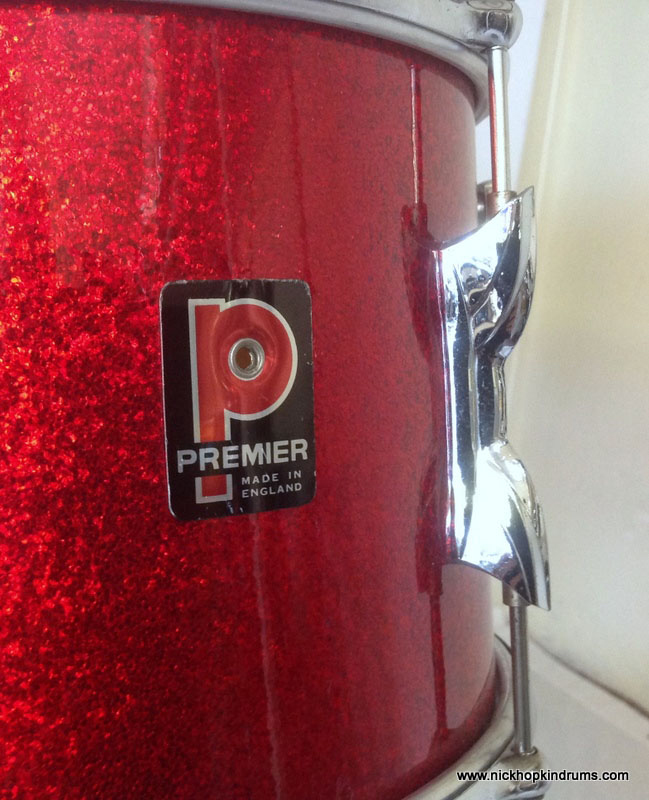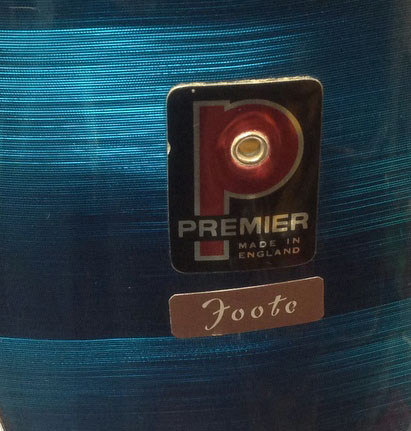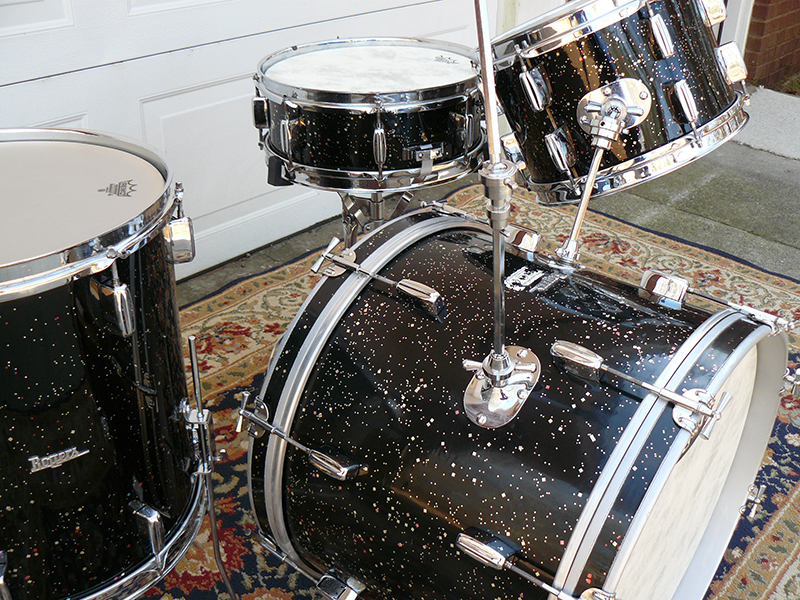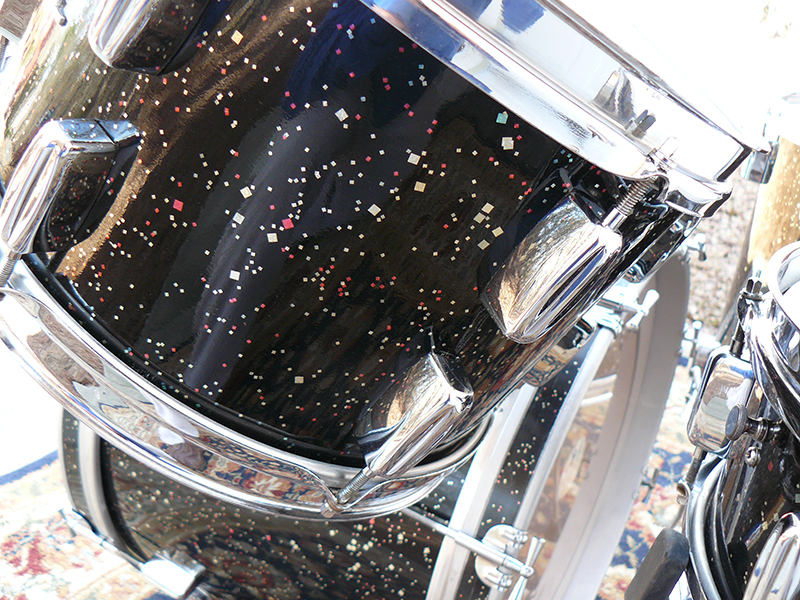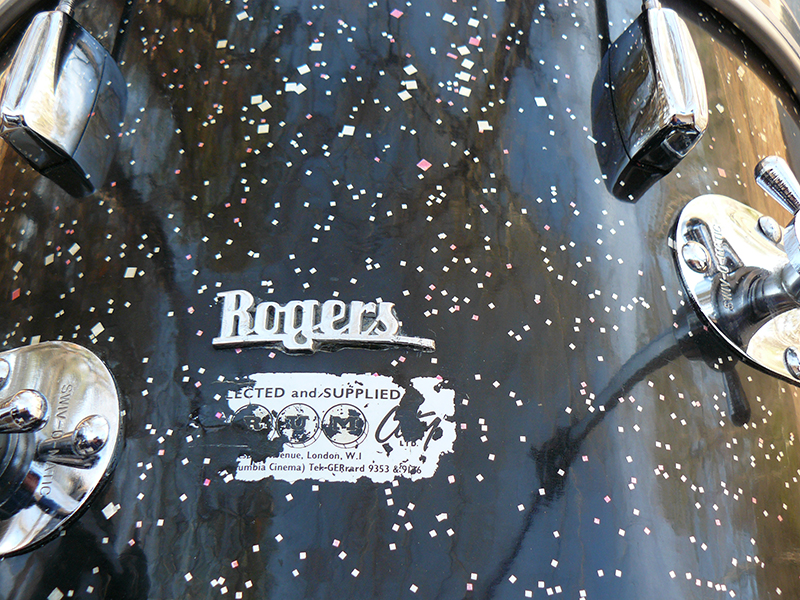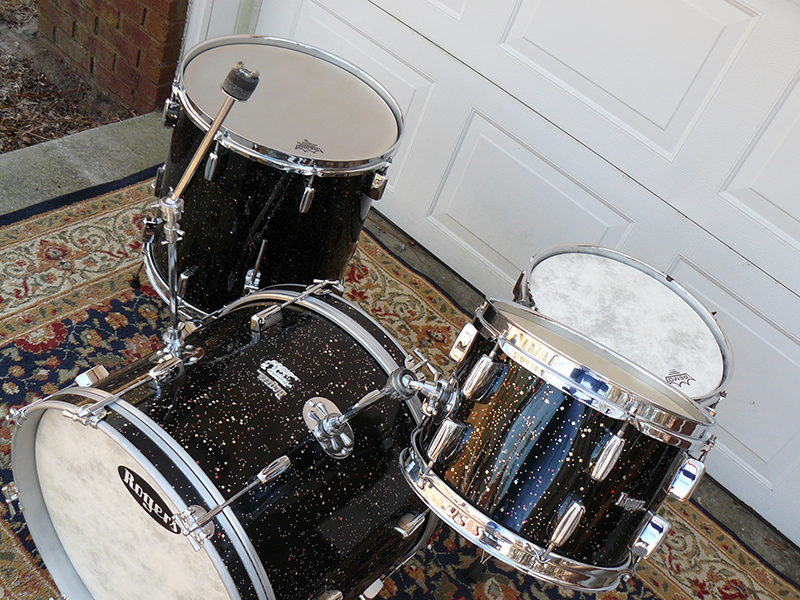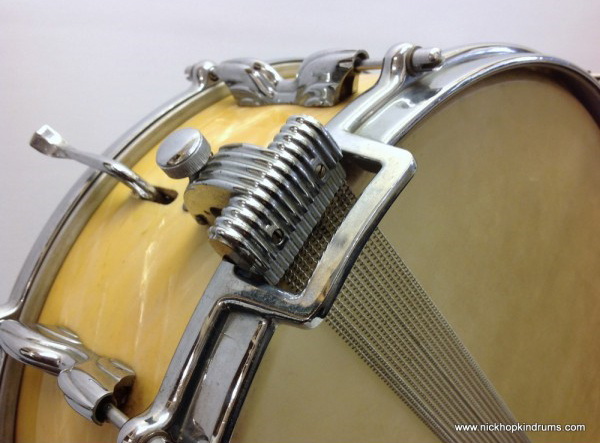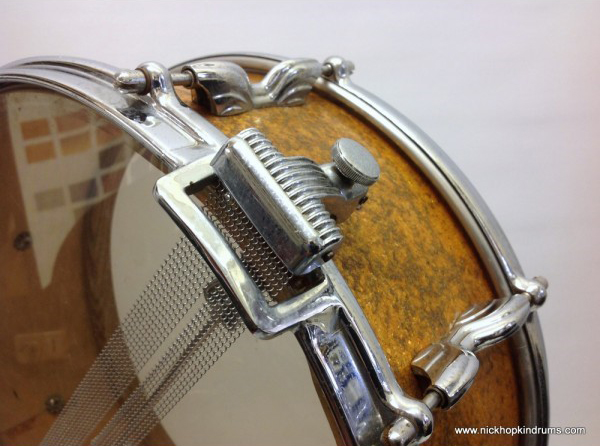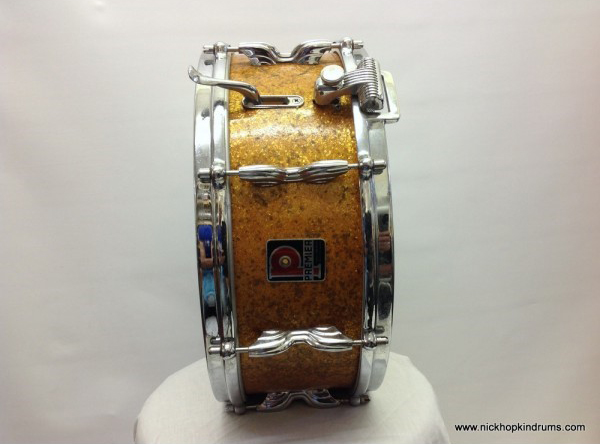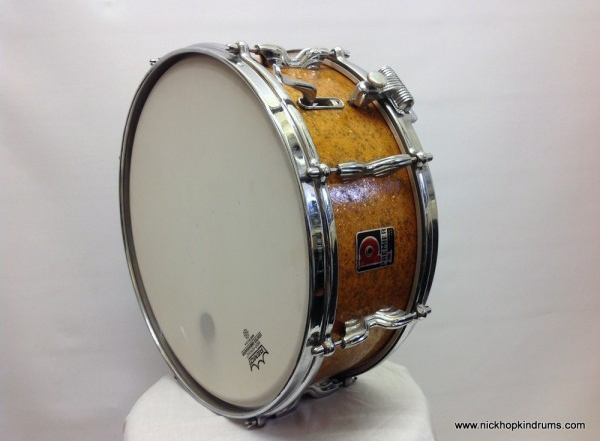1932-34 Slingerland 5x14 Artist DuAll Model (“Pulley” Version)
By Mike Curotto
Hi All,
A few years ago I was contacted by drummer/educator Ed Soph who wanted some information about this drum. I told him what I knew and after a few months I was able to purchase the drum from Ed. Over the years I have discovered three versions of the Slingerland DuAll mechanism: 1. A center post very similar to if not a direct copy of the Super-Ludwig center post (usually equipped with a Tone Flange). 2. An interior “pulley” type mechanism instead of a center post (no Tone Flange). 3. No center post and no “pulley” mechanism (no Tone Flange). This snare drum has the “pulley” mechanism
The Shell: Green Sparkle from the 1930s is notorious for having black “cancer” spots. Fortunately this drum is cancer free. The finish had the normal years of accumulated schmutz but everything cleaned up and polished up nicely. The interior of the solid maple shell was very clean with no re-ring separation other than a 2” section, no big deal. The shell has normal bearing edges top (no Tone Flange) and bottom . The cloud badge is very clean with a tight grommet. Lastly, a nice factory pre-assembly artifact was found on the interior of the shell...”Nickle DuAll”.
The Hardware: The nickel hardware was in great shape and was very easy to clean and polish. There were a few errant tension rods but I had the era-correct replacements in my parts stash.
The internal DuAll “pulley” mechanism is clean, well built and looks kind of artsy. The mechanism is smooth, works well but is not as solid as the center pole version that brought on the patent lawsuit by Ludwig & Ludwig. I’ve included interior and exterior photos of this version of the DuAll mechanism. The reader will clearly see the similarities to the already patented L & L Super-Ludwig mechanism of the same era. The manufacturer’s cartouche markings on the snare gates are “L” and “LL”.
The Slingerland Artist DuAll Model was only in production for approximately two years and due to this very limited production run Slingerland DuAlls are extremely rare. As far as my snare drum collection goes, my un-scientific guesstimate based on the number of Slingerland DuAlls I own vs. the number of L & L Super-Ludwigs I own is about 15:1 meaning for every DuAll I own there are 15 Super-Ludwigs that I own. If we look at the more realistic bigger picture out there in the collecting world my guestimate is more like 100:1. That’s just my very un-scientific observation. As always, feel free to weigh-in on the subject as I look forward to your comments and added information.
A nice Frank’s Drum Shop calf batter head, Slingerland slunk head and the original snares rounded out this cleaning/restoration.
Enjoy! Mike Curotto
2003 6.5x13 Craviotto/Steve Maxwell Collection Birch Lake Superior Timeless Timber Model
Hi all,
Here’s a snare drum that I’ve had for a while. A good friend of mine was the original owner and sold the drum to me about 10 years ago at the 2005 Chicago Vintage Drum Show.
This is a very rare, special order Craviotto snare drum that was part of the Steve Maxwell Collection (Steve is the world’s largest Craviotto dealer). Only two were made in 2003; #1 is in my collection and #2 is in Sweden last I heard. The story is that the original owner (and possibly the collector in Sweden) wanted a Craviotto Lake Superior Timeless Timber 700 year old solid birch snare drum in a 6.5 x 13 size. The order was placed with Steve Maxwell. I was told by three very reputable sources, Johnny, Steve Maxwell and Joe Kenny that in the process of bending the planks/boards Johnny broke 26 boards in order to get two perfect shells. Steve Maxwell was kind enough to let me quote the “broken boards story” in his own words: ”The deal with the broken boards was this: It isn't just the fact that it is a 13 that makes it hard, (because Johnny does 13s, 12s and 10s all the time with no issues). The issue was that it is specifically the Timeless Timber that made it almost impossible to bend a 13. The reason is that the Timeless wood is exceedingly hard from being under pressure in the lake for about 100 years. As a result, the 14 was really the smallest diameter that could be rolled without it becoming excessively wasteful due to broken boards.”
2003 6.5x13 CRAVIOTTO/STEVE MAXWELL COLLECTION BIRCH LAKE SUPERIOR TIMELESS TIMBER
The Shell: The solid birch shell has the typical Johnny Craviotto craftsmanship that he is famous for. The interior is signed and dated 2003. After I bought the drum I asked Johnny if he would authorize a new/updated name plate for me. He came through like a champ.
The Hardware: I’m not sure about drum #2 but this drum has nickel plated hardware, die cast rims and a Trick strainer with the Craviotto logo.
The drum has an Evans G1 batter, Craviotto/Remo snare side and Pure Sound 20 strand wires. The drum has a great “pop” to it and is used all the time in my drum studio.
I felt that this very rare Craviotto snare drum should be shared with my friends, fellow collectors and the vintage drum community.
Enjoy! Mike Curotto
Vintage Drum Heads
With vintage English drums a common enquiry is ‘are my drums pre-international size’?
There is a fair bit of confusion over which English drum manufacturers made shells slightly undersized or oversized, and even then there are misconceptions over which size drums are affected. Here I hope to clarify this for you and give some tips on how to determine if your vintage English drum set takes regular sized heads, or is indeed in ‘funny sizes’!
Premier made pre-international sized drums in a 20, 10, 12 and 16 (metric sized shells) on all sets pre-1967. All other Premier drum shells should be standard (international) sized, although there are exceptions (notably larger bass drums pre 1960, that were non-standard sized and fitted with calf heads – 22,24,26 etc). Premier made their own plastic drum heads ‘Everplay’ and ‘Everplay extra’ in the UK, but its worth a mention that in the 1966 catalogue they do an ‘American sized 12”, and 16” head and were manufacturing 13” heads although they didn’t have any 13” toms on their sets.
The actual measurements of pre international drums are as follows:
10” = 9 5/8” actual diameter 12" = 11-7/8" actual diameter 16" = 16-5/16" actual diameter 20" = 19-5/8" actual diameter
Sometime between 1968 and the early 1970’s all Premier shells became international (standard), and you can generally tell by the badge and kit set up. The 1968 Premier catalogue features a mixture of old and new set configurations but by 1972 all sets featured display configurations with regular shell sizes. It is in these intervening years that sets came out of the factory with just about every combination of standard and pre international sized drums. Typically there was a backlog of pre-international shells in the factory which made it into kit set ups, so many kits between 1968 and 1972 have a mixture of international and pre international shells, some with the earlier 1960’s badge, lugs and fittings, some with the later. It’s not unusual to have a kit with an international size bass drum and pre international 12 and 16 toms and often with a mixture of badges and fittings/mounts.
In the 1968 catalogue, Premier introduced the 14 x 8” tom (sometimes referred to as the ‘tuna fish can’ or the ‘pancake tom’) and its to be noted that this was standard sized. By 1972, Premier had introduced the 13 x 9” tom and from then all drums that came out of the factory were standard sized.
If in doubt when looking at a kit to buy, it’s worth noting that Pre international floor toms are always 10 lug, whilst the international shells were 8 lug. With the 12 x 8” tom and 20 x 14” bass drum, the lugs and badges are usually a good indication. If in doubt, its best to measure the shell’s diameter with the head off!
It should be noted that all Premier snare drums are a standard 14”.
Remo are the only manufacturer of pre-international heads, but now produce quite a range; coated and clear Ambassador as well as clear pinstripe are currently available. They will however make anything to order, in any size, so contact your dealer if you fancy something else or have an unusual size bass drum. I recently had some pre international sized Fibreskyn heads on a special order and have some other pre international head options coming soon.
Other 1960’s English drums often require pre-international heads – Dallas (Carlton, President), Olympic, John Grey (Autocrat, Broadway) and some of their snare drums are slightly under or over 14”. Currently there are no heads available off the shelf for these snare drums, but as mentioned Remo will make heads to fit.
It’s worth noting that both Boosey & Hawkes (Ajax, Edgeware, Stratford), Beverley and Hayman never made pre-international sized drum shells so standard heads will fit these drums. I always have Remo Pre international heads in stock at Nick Hopkin Drums and can have anything made to order. Drop me an email if you want to discuss specifics for your set, or head options.
1960 English Rogers Set
It is hard for me to believe we are already in to February. Where did January go? My Mother told me when I was young and wishing for my birthday, Christmas, or school to be out that time would go a lot faster when I grew up. She was right, as always, and time now really get away in a hurry. I am looking forward, but not wishing my life away, to some great drum shows this year. I hope you can attend one in your area this year. Keep watching for the places and dates to be listed here in the magazine. Getting together with other vintage and custom drum collectors and players is always fun and educational. I am constantly learning information about vintage drums from my drum collector friends. A lot of my contacts and friends were made at drum shows.
I decided to feature a set this month for your enjoyment that I recently acquired. It's an early 1960s English Rogers set in rare Madi Gras finish. I have wanted a Rogers or Slingerland set in Madi Gras finish for years. I just love that finish. By the way, Madi Gras is this month in New Orleans. I've never been to Madi Gras, but I have that trip on my bucket list, but back to my desire for a Madi Gras drum set. I have been looking for a Madi Gras set to add to my collection, and as I was searching E-Bay a few weeks ago a set was there for sale. I really wanted them and had decided to place a bid when the end of the sale came around. I usually wait to bid until the end of the sale. I have jumped in right at the beginning, but usually I wait. Maybe you could leave a comment and share your E-Bay bidding strategy. The Madi Gras set on E-Bay was a Rogers set and that was fine with me. It's no secret to my readers that I love Rogers drums. While I was watching that set, another Rogers Madi Gras set showed up on Facebook. The set for sale on Facebook was the English Rogers set I am showing you. Yes, I made a deal with the seller and he shipped them to me from Canada. I am so excited about them.
English Rogers drums were made in the 1960s at the Boosey & Hawkes drum factory in London. They had Ajax three ply shells with reinforcement rings. The interiors are clear coated not painted like American Rogers. The lugs are Bread and Butter style, and the mounts are Swivomatic style, but they are different from the USA parts. The Madi Gras finish is also different from the American version, not as busy. The script logo badges also look different. The sizes of this set are: bass drum 20"X15", floor tom 16"X16", mounted tom is 12"X8", and the matching snare is 14"X5". Many of you know that Dave Clark of the Dave Clark Five played English Rogers drums. English Rogers drums were not a huge success, but they are very cool drums. Many collectors want to have a replica of John Bonham's set or a Ringo's set. I would like to have a red sparkle English Rogers set with a Dave Clark logo head. He was one of my greatest influences.
My set was owned by a member of the Toronto Symphony who brought them from England. When he returned to England to retire he left the set in Canada with a new owner. There is a cool Drum City London sticker on the bass drum. I was tempted to try to finish removing it. It looks like someone started to take it off but didn't go through with it. I have decided to leave it. It has been there fifty years, and it adds to the story of the drums, so for now the sticker stays. The man who helped me buy these drums from the owner who acquired them from the symphony percussionist was a super guy. He did a great job handling the sale and shipping the drums from Canada to my door. I want to thank him again for the great job he did. Leave a comment if you have an English Rogers set or if you liked Dave Clark Five. Keep looking in those unusual places for a great old drum.
WIW? 40-50s Leedy Ludwig Kit
Got something that you want to ask the community what’s it worth? Send it in and we’ll post it here. – NSMD
Hello-
Here's an entry for What's It Worth: my uncle's old 40's-50's kit. Leedy Ludwig 20"bass and 13" tom. Not sure of franken-snare, has Leedy lugs, new bottom rim and snare throw off. I'm not a restorer, but I did get them player ready. Bass and mounted tom seem to be original, floor tom is his old high school marching drum recovered for tom use. I do have everything to make it back into the original marching share. All original Leedy hi-hat with 14" Zildjian cymbals. Leedy Ludwig bass drum pedal, with a clamp for mounted tom and clamp-on cymbal - older with 16" Zildjian crash-ride. No extra holes for tom or cymbal mounts. This what he was using until he bought his brand new set of '58 Gretsch Drums. They play and sound great. I know its hard to put a value on this unseen but they are in good -very good condition.
Thanks, Ronnie
What do you think? Let us know in the comments below!
Premier Super Ace Snare Drum
Prior to the popular Premier Royal Ace snare drum of the 1960’s, Premier had some other classic snare drums that worked with an internal parallel snare mechanism.
Premier launched the Ace snare drum in the 30’s, which progressed through various design changes over the decades until becoming the Royal Ace in the 1960s. Prior to its final incarnation, In 1958 Premier launched the ‘Super Ace’ in their 1958 catalog as ‘Premiers greatest achievement’. With its exclusive parallel snare mechanism, it boasted perfect response with heads and snare wires at any tension, with absolutely no snare buzz when the wires were thrown off.
The shell had a lever midway, which gave the player control of the internal snare mechanism. Moving the lever up or down effectively switched the snares on or off (via a bar positioned horizontally through the shell, with the butt ends attached). The design of the lever and the butt ends are very art deco, chromium plated to the highest standard, as expected on all vintage Premier. Their chrome really was second to none. The drum featured flush braced lugs, slot tension rods and die cast hoops (with shallower rims than previous drums to ‘allow for faster playing’).
The wooden shelled Super Aces came in several sizes, the standard being 5.5 and 6.5, but with a 4” model available as well as 8”. I’ve never seen an 8” model, but would love to hear one. (If anyone has one, please send some pictures). Their sound was very much like the Royal Ace that I’ve discussed in previous issues; warm with a nice ring from the die cast hoops and a real sensitivity, with the added ability to give a strong backbeat without losing tone. The drums were available in a good selection of colours and finishes; Marine pearl, black pearl, silver, gold, aquamarine & red sparkle, white & black duroplastic.
The drum was also available in a metal shell at both 6.5 and 12”. These were the Concert Ace’s, initially designed for orchestral and symphony work, but quickly becoming one of the most sought after snare drums in the USA in their time. I haven’t seen or played a 12”, which is described in the catalogues as capable of ‘every degree of volume from a whisper to a tremendous roar’. I recently had a 6.5” Concert Ace in the shop; with its chrome over brass shell and die cast hoops, this drum could give any of the other big names 6.5” COB’s a run for their money in my opinion. Its new owner is Matt Helders of the band Arctic Monkeys.
The snare wires on these drums were a single 20 strand wire which hooked onto a bar inside each butt end; some of the earlier models had a slightly different set of wires which screwed directly into the base of the snare butts. (See pictures). These wires are getting hard to come by, but there are people who can build replica sets or repair and modify older wires. Email me if you need some made.
A classic snare drum that went on to become the Royal Ace (which I’ve discussed previously), Premier’s flagship snare drum of the 1960’s. Expect to pay around $400 for a drum in good working condition with original wires.
1960s Zim Gar Stencil Drum Set
I want to feature a 1960s Zim Gar stencil set from my collection this month. Most of you know these sets were made in Japan. Sometimes you will see them listed as MIJ drums. They were made at the Pearl and Star (Tama) factories and imported in to the United States as a cheaper alternative to the great American drums.
Read more1950-55 Leedy & Ludwig 5x14 "Zebra" Broadway Standard
I got this drum from Bun E. Carlos at the 2013 Chicago Vintage Drum Show. Bun E. Carlos had the only two known Leedy & Ludwig Zebra snare drums, a 4 x 14 Broadway New-Era and a 5 x 14 Broadway Standard. He sold me the 5 x 14 Broadway Standard. The drum was previously owned by Mark Cooper of Coopers Vintage Drums and a special thanks goes to Mark for the additional info on this drum. Bun E. also helped me to authenticate the Zebra finish by giving me a few photos of his Leedy & Ludwig “Salesman Sample” floor tom shell that shows the Zebra finish as one of the samples. Bun E. added this: "The wrap was available to the general public. Aside from your drum, and my 5 drums, I've seen only 2 other Zebra drums, a big bass drum and floor tom on EBay a few years back. Only 8 drums, rarer than an original Triumphal!!!!! Haha!!"...? I love Bun E.’s wry sense of humor.
Read moreWilliam Kent (1915-2014)
William Kent, co-founder of the Kent Drum Company, passed away in his Buffalo, New York area home on December 11, 2014. William turned 99 years old last month and passed after a very short illness.
In 1947 William and Ed Kent opened the Kent Drum Company in Kenmore, NY with a focus to create student-level kits, encouraging music making at all economic levels. The company also offered professional-level drum sets, snare drums and percussion accessories. William was always proud of a common story told throughout the industry - "A Christmas morning surprise, in 1964 or 1965... for the young Ringo want-to-be, a new Kent Drum set under the tree!" The company closed in 1977, allowing William and Ed to retire. Drum Paradise, their retail shop next to the factory, closed the following year.
William Kent's 2013 NAMM Oral History interview: https://www.namm.org/library/oral-history/william-kent
---
Text courtesy of Dan Del Fiorentino, NAMM Music Historian.
Master Blaster
As with many drums of the 18th and 19 centuries, this full-barrel bass was more than likely hand crafted by a trunk and furniture maker, or possibly even a coach and carriage builder. The main tack pattern surrounding the sling attachments is very common to that which was used on the lids of storage or travel trunks of the era. A drum maker would normally have his own unique tack pattern to identify his work as opposed to a commonly used utilitarian tack design familiar to trunk builders. A secondary brass tack pattern of a circle within a circle is located surrounding the unreinforced vent hole.
Read more1932-34 Slingerland 6.5x14 Duco DuAll
A very brief history for those that may not know the history of the Ludwig Super vs. Slingerland DuAll battle: Ludwig & Ludwig had the patent (1924) for their parallel (Super-Ludwig) mechanism. Along comes Slingerland with their version of a parallel mechanism that they called the DuAll model. Ludwig felt that Slingerland’s DuAll mechanism was infringing on their Super-Ludwig mechanism so they sued Slingerland and won. The court ordered Slingerland to discontinue their DuAll model and I seem to remember reading that Slingerland had to pay L & L the money that was made on their sales of the DuAll models. DuAlls were in production for less than two years so these snare drums are extremely rare.
Read more1960s Rogers Cleveland Holiday Set
This set is a beautiful blue glass glitter finish that has developed a texture. They are not smooth to the touch. It is uniform over the complete set. I would like one of the Rogers experts to shed some light on this mystery for me. The paper labels inside indicate that these are Cleveland Holiday models. The solid grey interiors indicates that these are early 1960s. I have been told the Cleveland and the Dayton models were both made at Covington. Production was later moved to Fullerton.
Read more1940 Radio Kings - A Family Tradition
I was scrolling through a vintage drummer Facebook group one day, and I came across a post from Joe Ciucci. Rather, I came across an open-mouth drool worthy video of his 1940 restored Slingerland Radio Kings…. Joe was just the guy attached to the post! I sent a message to Joe, and we struck up a conversation. Joe turned out to be as nice as his drums, and I offered to showcase the drums in Not So Modern Drummer. He took me up on the offer, and here we are today. Joe was instrumental in setting up our Nashville Drum Show trip to ATL Drum Collective, and if you came to the Nashville show, you couldn't have missed the Radio Kings in the vintage drum museum.
Read moreBrooklyn Walking Tour: Traveling Through Gretsch History Today
This past July 30th 2014 I had a unique opportunity to take a step back into Gretsch Company history. As a matter of fact, I actually took several hundred steps, as I walked the streets of the Williamsburg section of Brooklyn where the company got its start. Along the way I visited several sites that mark the evolution of the company from its inception in 1883 through 1969, some seven decades later. Best of all, I had the pleasure of being joined by more than twenty drummers who are fans of Gretsch drums and their fascinating history. Since these drummers were all from the New York area, the information offered in our “Brooklyn Walking Tour” was all the more personal for them.
Read moreRick Latham's Polish Snare Drum
We got this question from Rick Latham as he was ending his summer tour in Europe.Can any of you help us out here? - NSMD: Hi George, Greetings brother from the Black Forest of Germany! Hope you are doing well. I'm nearing the end of a three month tour here in Europe - Germany, Italy, France, Poland, Switzerland... all great! I ran across this drum in a drum shop in Poznan, Poland and the guys are curious if it's anything cool - or maybe a bastardized-something-weird? Ha! I told them if anyone would know, it would be you - so give it your best shot.
Read more1960s Ludwig Downbeat Set
The drum set from my collection that I want to feature this month is a 1960s Ludwig Downbeat Set in sparkling pink champagne pearl. Downbeat sets began in 1959. It is one of my all time favorite kits. I really love these drums for many reasons. Their sizes are one reason I love them. These are the size drums Ringo Starr played on the earlier Ed Sullivan shows. The Bass drum is 20"X14", the floor tom is 14"X14" and the mounted tom is 12''X8". Ringo referred to the Downbeat sets he owned as the "mini" kits. I used to have a hard time telling if a kit was a Downbeat set in photos, but I learned to count the bass drum T- rods. The Downbeat set has 8 lugs and the 22"X14" Super Classics have 10 lugs. Another way to tell is to look at the lugs on the mounted tom. The space is greater between the top and bottom lugs on the 12'' tom than the space on the 13" tom. The 13" tom used on the Super Classics has larger lugs, so the space between them is smaller.
Read moreDW "Buddy Rich" Drum Set
This is a Drum Workshop set that I purchased March of 1983 that was custom built for Buddy Rich in August 1982. He used it for the beginning of the 1983 tour and played them until he had the heart attack when he was in Ann Arbor Michigan. It was ordered and built to his specifications through Joe Cusatis at the modern drum shop in NYC. He wanted the Slingerland TDR throw off on the snare, He wanted Pearl spurs and a Ludwig rail/banana mount for the tom tom. He also wanted Ludwig cymbal holders for the bass drum. The rest of the set is DW but is wrapped in Ludwig white marine pearl. It has the BR on the front bass drum head and "Buddy Rich Fragile" on the cases.
Read more1925 Ludwig & Ludwig Triumphal #9
This drum is definitely a 1920s Ludwig & Ludwig gold plated /engraved Triumphal Model. I did notice a few minor differences as compared to my Triumphal... 1. This drum has a 5-petal rose engraving as compared to my drum that has a 6-petal rose engraving... 2. This drum has the “Ludwig Chicago” in the same panel as the P-338 strainer as compared to my drum where the “Ludwig Chicago” is located 2 panels to the left of the strainer. Nothing earth shattering but interesting enough for me to pursue it further, ergo; was this a different engraver than my drum?
Read moreThe WWII Collection
"Here are a couple of pics of the World War II collection. The L&L is completely restored. The 1st version WFL (with the rolling bomber snare) werepurchased new, played for a year at home and put in the closet for 70+ years - they still have the original Calf heads on them. I am the 2nd owner. A BDP Rollin Bomber kit with a very rare 10" off set lug tom. I am the second owner as well. At the show I will also have a 1st version (Cecil Stupe design) WFL internal tune kit in WMP that I am restoring."
Read more










